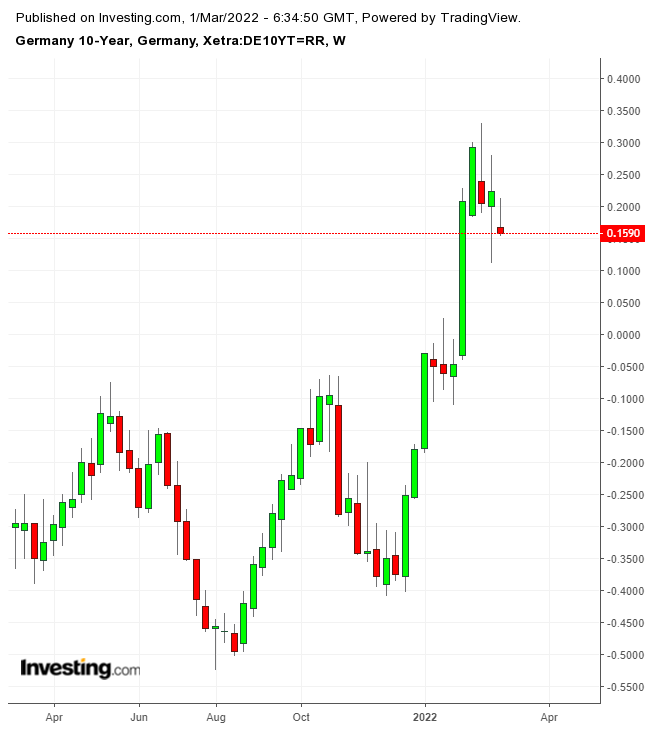As hundreds of thousands of Ukrainians flee the Eastern European country to escape Russia’s brutal military invasion, global investors are seeking safe havens of their own, piling into US Treasuries and causing yields to plunge.

The 2% yield on the benchmark 10-year Treasury note is just a memory; the yield plunged to about 1.89% Monday afternoon, continuing its slide from the previous week.
Western sanctions against Russia, including an unprecedented decoupling of some banks from the SWIFT international payments system, had an immediate impact, forcing Russia’s central bank to more than double its interest rate to 20% and shut the Moscow stock exchange.
When Russian President Vladimir Putin announced he was putting the country’s nuclear deterrence on high alert, if not sooner, investors realized how serious and dangerous the situation had become.
War In Europe Prompts More Caution From Policymakers
Federal Reserve Chairman Jerome Powell will testify in Congress this week for his semiannual monetary policy review. Most people now expect the Fed to move ahead with its plans to raise interest rates later this month, but it could be a long two weeks between his appearance before the House Financial Services Committee on Wednesday and the end of the Federal Open Market Committee meeting on Mar. 16.
The Fed’s dilatory approach to combating inflation now seems to be coming back to bite policymakers, as the impact of Russian sanctions can both accelerate price increases and dampen global growth, increasing the urgency to act but exacerbating its impact.
Current prices indicate market expectations of a quarter-point hike in March, but the course of the Ukraine war makes everything uncertain. The half-point hike touted last week by some policymakers as a possibility is now considered less likely, but data on employment and inflation in the next couple of weeks could spur a bigger move.

Government bond yields in Europe also fell, with yield on the German 10-year, which serves as a benchmark for the eurozone, declining nearly 5 basis points on Monday to finish just below 0.11%. The European Central Bank has been more cautious in its approach to monetary tightening and war on its doorstep is likely to add to that caution.
Robust growth has driven market expectations, but it is difficult to forecast the impact of disrupting Russian exports, particularly in energy and grain. Deliveries of grain and other exports through Black Sea ports, one of the hot spots in the invasion, will be blocked for an indefinite period, while Germany has already halted approval of a new Baltic pipeline for Russian gas and the existing pipeline through Ukraine has been a target of missile fire.
Italian bond yields, which actually rose in early February and remained relatively impervious to the crisis as it developed, have also fallen, with the 10-year yield dipping near 1.7% on Monday after nearing 2% in mid-February.
The spread in yields between the German 10-year and the Italian 10-year, after widening to 169 bps at one point, has narrowed to 161 bps.
Ukraine President Volodymyr Zelenskyy has formally applied for EU membership, urging a fast-track procedure instead of the years normally required. European Commission President Ursula von der Leyen, while saying the EU would welcome Ukraine as a member, cautioned that accession is a complex process of integration.
ECB President Christine Lagarde faces the same dilemma as the Fed’s Powell, figuring out how to curb inflation while offsetting the deflationary effects of the Ukraine conflict and Russian sanctions.
